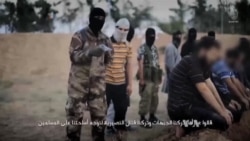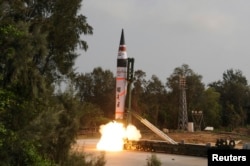Less than three months into his presidency, Barack Obama looked out at the thousands of people packed into Prague's Hradcany Square and told them that as the only nation to ever use a nuclear weapon, the United States had a moral responsibility to work toward a world without them.
"One nuclear weapon exploded in one city — be it New York or Moscow, Islamabad or Mumbai, Tokyo or Tel Aviv, Paris or Prague — could kill hundreds of thousands of people," he said. "And no matter where it happens, there is no end to what the consequences might be for our global safety, our security, our society, our economy, to our ultimate survival."
From that speech came a series of international summits on nuclear security in 2010, 2012 and 2014 that pushed dozens of countries to boost the security of their nuclear material to prevent it from falling into the hands of terrorists. But even with those gains, work on the main goals of the summits remains incomplete.
Obama said in his 2009 speech that a terrorist acquiring a nuclear weapon was "the most immediate and extreme threat to global security."
Securing sites
To lessen the chance of that happening, those at the summits have focused on securing sites that utilize nuclear and radiological materials and cutting overall stockpiles so there is not as much available to steal. Militants weighing their chances of success likely will not try to grab a nuclear weapon from a U.S. military site, but could go after an easier target — like a medical lab stocked with radioactive isotopes for research.
WATCH: Experts warn of nuclear material falling Into terrorists' hands
The 2014 summit included a pledge from 23 countries to lock down their most dangerous radioactive materials, ones that terrorists could place inside a conventional explosive to create a "dirty bomb."
As the 2016 summit convenes, 22 of those countries have met their goals, but as the Nuclear Threat Initiative highlighted in a recent report on radiological security, there were 53 countries at that summit and 168 members of the U.N.'s nuclear watchdog, meaning many more need to take action.
"This is noteworthy progress, and I applaud these countries who are willing to lead," said NTI CEO and former U.S. Senator Sam Nunn. "However, the ingredients for a radiological dirty bomb are located at tens of thousands of sites in more than 100 countries, many of them poorly secured and vulnerable to theft."
While more difficult to obtain, a bomb made with highly enriched uranium or plutonium would have far more devastating effects. Current estimates put the global stockpile of weapons-grade uranium at about 1,400 tons, enough to make 20,000 bombs like the one the U.S. dropped on the Japanese city of Hiroshima in 1945.
Uranium stockpiles, both civilian and military, have been declining since the mid-1990s, according to a report by the International Panel on Fissile Materials. Plutonium has followed when it comes to weapons, but the amount stored for civilian purposes has risen.
Summits' progress
Even so, the White House says the summits have led to the decline in the number of sites with nuclear material, with removals taking place at 50 facilities in 30 countries totaling enough to build 150 weapons. Officials highlighted the fact that Ukraine got rid of all its highly enriched uranium, and 14 countries have eliminated nuclear materials from their territory.
The White House said 36 countries have collectively installed radiation detection equipment at 329 international points of entry to try to prevent any stolen materials from being smuggled across borders. The summits have also led to the establishment of training centers in 15 countries for nuclear security.
William Tobey, a former deputy administrator for defense nuclear non-proliferation at the U.S. National Nuclear Security Administration, wrote in Defense One that the 2016 summit needs to expand training and certification for those tasked with security of nuclear material. He said that complacency about security puts every site with nuclear material at risk.
"Unfortunately, while more than 200,000 people around the world have some accountability for the security of nuclear or radiological material, only about half of them report having an opportunity for professional development," he said.
Even with all of the sites secure, opponents of nuclear weapons — such as the group Global Zero — say as long nuclear weapons exist, "there can be no such thing as nuclear security."
Global Zero appealed to those taking part in the 2016 summit to develop concrete plans for eliminating all of the roughly 15,000 nuclear weapons in the world, most of which belong to the United States and Russia. Those two countries do have plans to cut their arsenals, but not yet to zero.
"I'm not naive," Obama told the crowd in Prague seven years ago. "This goal will not be reached quickly — perhaps not in my lifetime. It will take patience and persistence, but now we, too, must ignore the voices who tell us that the world cannot change. We have to insist, 'Yes, we can.' "













